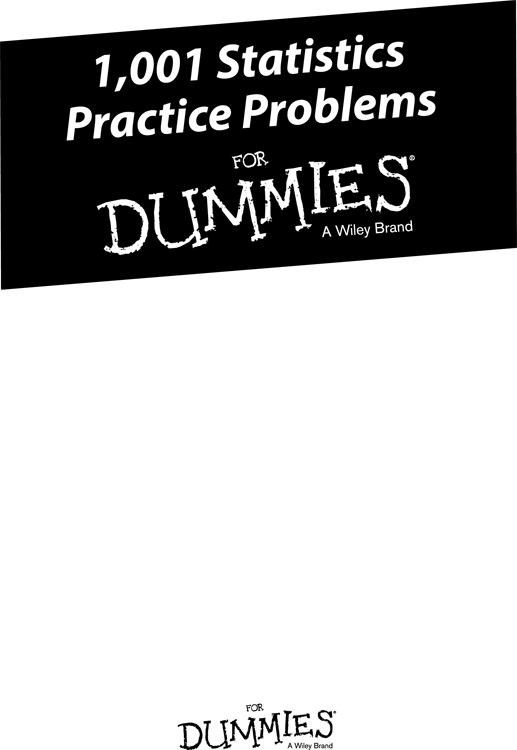
1,001 Statistics Practice Problems For Dummies
Published by: John Wiley & Sons, Inc., 111 River Street, Hoboken, NJ 07030-5774, www.wiley.com
Copyright 2014 by John Wiley & Sons, Inc., Hoboken, New Jersey
Published simultaneously in Canada
No part of this publication may be reproduced, stored in a retrieval system or transmitted in any form or by any means, electronic, mechanical, photocopying, recording, scanning or otherwise, except as permitted under Sections 107 or 108 of the 1976 United States Copyright Act, without the prior written permission of the Publisher. Requests to the Publisher for permission should be addressed to the Permissions Department, John Wiley & Sons, Inc., 111 River Street, Hoboken, NJ 07030, (201) 748-6011, fax (201) 748-6008, or online at http://www.wiley.com/go/permissions .
Trademarks: Wiley, For Dummies, the Dummies Man logo, Dummies.com, Making Everything Easier, and related trade dress are trademarks or registered trademarks of John Wiley & Sons, Inc., and may not be used without written permission. All other trademarks are the property of their respective owners. John Wiley & Sons, Inc., is not associated with any product or vendor mentioned in this book.
LIMIT OF LIABILITY/DISCLAIMER OF WARRANTY : WHILE THE PUBLISHER AND AUTHOR HAVE USED THEIR BEST EFFORTS IN PREPARING THIS BOOK, THEY MAKE NO REPRESENTATIONS OR WARRANTIES WITH RESPECT TO THE ACCURACY OR COMPLETENESS OF THE CONTENTS OF THIS BOOK AND SPECIFICALLY DISCLAIM ANY IMPLIED WARRANTIES OF MERCHANTABILITY OR FITNESS FOR A PARTICULAR PURPOSE. NO WARRANTY MAY BE CREATED OR EXTENDED BY SALES REPRESENTATIVES OR WRITTEN SALES MATERIALS. THE ADVICE AND STRATEGIES CONTAINED HEREIN MAY NOT BE SUITABLE FOR YOUR SITUATION. YOU SHOULD CONSULT WITH A PROFESSIONAL WHERE APPROPRIATE. NEITHER THE PUBLISHER NOR THE AUTHOR SHALL BE LIABLE FOR DAMAGES ARISING HEREFROM.
For general information on our other products and services, please contact our Customer Care Department within the U.S. at 877-762-2974, outside the U.S. at 317-572-3993, or fax 317-572-4002. For technical support, please visit www.wiley.com/techsupport .
Wiley publishes in a variety of print and electronic formats and by print-on-demand. Some material included with standard print versions of this book may not be included in e-books or in print-on-demand. If this book refers to media such as a CD or DVD that is not included in the version you purchased, you may download this material at http://booksupport.wiley.com . For more information about Wiley products, visit www.wiley.com .
Library of Congress Control Number: 2013954236
ISBN 978-1-118-77604-9 (pbk); ISBN 978-1-118-77605-6 (ebk); ISBN 978-1-118-77616-2 (ebk)
Manufactured in the United States of America
10 9 8 7 6 5 4 3 2 1
Publishers Acknowledgments
Executive Editor: Lindsay Sandman Lefevere
Senior Project Editor: Georgette Beatty
Copy Editor: Jennette ElNaggar
Contributor: LearningMate Solutions
Contributing Editor: Deborah J. Rumsey, PhD
Technical Editors: Jason Molitierno, David Unger
Art Coordinator: Alicia B. South
Project Coordinator: Erin Zeltner
Illustrator: Ryan Sneed
Cover Image: iStockphoto.com/Natalia Silych
Chapter 1
Basic Vocabulary
Everythings got its own lingo, and statistics is no exception. The trick is to get a handle on the lingo right from the get-go, so when it comes time to work problems, youll pick up on cues from the wording and get going in the right direction. You can also use the terms to search quickly in the table of contents or the index of this book to find the problems you need to dive into in a flash. Its like with anything else: As soon as you understand what the language means, you immediately start feeling more comfortable.
The Problems Youll Work On
In this chapter, you get a birds-eye view of some of the most common terms used in statistics and, perhaps more importantly, the context in which theyre used. Heres an overview:
- The big four: population, sample, parameter, and statistic
- The statistics terms youll calculate, such as the mean, median, standard deviation, z-score, and percentile
- Types of data, graphs, and distributions
- Data analysis terms, such as confidence intervals, margin of error, and hypothesis tests
What to Watch Out For
Pay particular attention to the following:
- Pick out the big four in every situation; theyll follow you wherever you go.
- Really get the idea of a distribution; its one of the most confusing ideas in statistics, yet its used over and over so nail it now to avoid getting hammered later.
- Focus not only on the terms for the statistics and analyses youll calculate but also on their interpretation, especially in the context of a problem.
Picking Out the Population, Sample, Parameter, and Statistic
Youre interested in knowing what percent of all households in a large city have a single woman as the head of the household. To estimate this percentage, you conduct a survey with 200 households and determine how many of these 200 are headed by a single woman.
. In this example, what is the population?
. In this example, what is the sample?
. In this example, what is the parameter?
. In this example, what is the statistic?
Distinguishing Quantitative and Categorical Variables
Answer the problems about quantitative and categorical variables.
. Which of the following is an example of a quantitative variable (also known as a numerical variable)?
(A) the color of an automobile
(B) a persons state of residence
(C) a persons zip code
(D) a persons height, recorded in inches
(E) Choices (C) and (D)
. Which of the following is an example of a categorical variable (also known as a qualitative variable)?
(A) years of schooling completed
(B) college major
(C) high-school graduate or not
(D) annual income (in dollars)
(E) Choices (B) and (C)
Getting a Handle on Bias, Variables, and the Mean
Youre interested in the percentage of female versus male shoppers at a department store. So one Saturday morning, you place data collectors at each of the stores four entrances for three hours, and you have them record how many men and women enter the store during that time.
. Why can collecting data at the store on one Saturday morning for three hours cause bias in the data?
(A) It assumes that Saturday shoppers represent the whole population of people who shop at the store during the week.
(B) It assumes that the same percentage of female shoppers shop on Saturday mornings as any other time or day of the week.
(C) Perhaps couples are more likely to shop together on Saturday mornings than during the rest of the week, bringing the percentage of males and females closer than during other times of the week.
(D) The subjects in the study werent selected at random.
(E) All of these choices are true.
. Because a variable is a characteristic of each individual on which data is collected, which of the following are variables in this study?
(A) the day you chose to collect data
(B) the store you chose to observe
(C) the gender of each shopper who comes in during the time period
(D) the number of men entering the store during the time period
(E) Choices (C) and (D)
. In this study, _____ is a categorical variable, and _____ is a quantitative variable.
Next page












